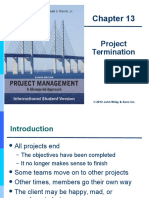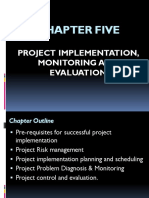0 ratings0% found this document useful (0 votes)
145 viewsChapter 4 (Project Management)
Chapter 4 (Project Management)
Uploaded by
Nyein WaiThe document discusses project budgeting and cost estimating. It covers topics like top-down versus bottom-up budgeting, work breakdown structures, estimating direct and indirect costs, and dealing with budget uncertainty. Budgeting involves forecasting resource needs, quantities, costs, and timing. Top-down uses manager experience, while bottom-up involves task owners. Costs include direct materials, labor, and overhead. Uncertainty comes from errors, changes, and new information.
Copyright:
© All Rights Reserved
Available Formats
Download as PPTX, PDF, TXT or read online from Scribd
Chapter 4 (Project Management)
Chapter 4 (Project Management)
Uploaded by
Nyein Wai0 ratings0% found this document useful (0 votes)
145 views32 pagesThe document discusses project budgeting and cost estimating. It covers topics like top-down versus bottom-up budgeting, work breakdown structures, estimating direct and indirect costs, and dealing with budget uncertainty. Budgeting involves forecasting resource needs, quantities, costs, and timing. Top-down uses manager experience, while bottom-up involves task owners. Costs include direct materials, labor, and overhead. Uncertainty comes from errors, changes, and new information.
Copyright
© © All Rights Reserved
Available Formats
PPTX, PDF, TXT or read online from Scribd
Share this document
Did you find this document useful?
Is this content inappropriate?
The document discusses project budgeting and cost estimating. It covers topics like top-down versus bottom-up budgeting, work breakdown structures, estimating direct and indirect costs, and dealing with budget uncertainty. Budgeting involves forecasting resource needs, quantities, costs, and timing. Top-down uses manager experience, while bottom-up involves task owners. Costs include direct materials, labor, and overhead. Uncertainty comes from errors, changes, and new information.
Copyright:
© All Rights Reserved
Available Formats
Download as PPTX, PDF, TXT or read online from Scribd
Download as pptx, pdf, or txt
0 ratings0% found this document useful (0 votes)
145 views32 pagesChapter 4 (Project Management)
Chapter 4 (Project Management)
Uploaded by
Nyein WaiThe document discusses project budgeting and cost estimating. It covers topics like top-down versus bottom-up budgeting, work breakdown structures, estimating direct and indirect costs, and dealing with budget uncertainty. Budgeting involves forecasting resource needs, quantities, costs, and timing. Top-down uses manager experience, while bottom-up involves task owners. Costs include direct materials, labor, and overhead. Uncertainty comes from errors, changes, and new information.
Copyright:
© All Rights Reserved
Available Formats
Download as PPTX, PDF, TXT or read online from Scribd
Download as pptx, pdf, or txt
You are on page 1of 32
ENGINEERING PROJECT
MANAGEMENT
DAF - 211
Dr. Khin Marlar Maung
Professor
Department of Commerce
Meiktila University of Economics
Meredith, J. R., Shafer, S. M., &
Mantel, S. J. Jr. (2017). Project
Management in Practice (6th
ed.). John Wiley & Sons, Inc.
Chapter 4
Budgeting the Project
Introduction
Once the budget is developed, it acts as a tool for
upper management to monitor and guide the
project.
Appropriate data must be collected and accurately
reported in a timely manner or the value of the
budget to identify current financial problems or
anticipate upcoming ones will be lost.
This collection and reporting system must be as
carefully designed as the initial project plans
because late reporting, inaccurate reporting, or
reporting to the wrong person will negate the
main purpose of the budget.
4.1 Methods of Budgeting
Budgeting is simply the process of
forecasting what resources the project will
require, what quantities of each will be
needed, when they will be needed, and how
much they will cost.
Most businesses and professions employ
experienced estimators who can forecast
resource usage with amazingly small errors.
Top-Down Budgeting
The top‐down approach to budgeting is
based on the collective judgments and
experiences of top and middle managers
concerning similar past projects.
These managers estimate the overall project
cost by estimating the costs of the major
tasks, which estimates are then given to the
next lower level of managers to split up
among the tasks under their control, and so
on, until all the work is budgeted.
Top-Down Budgeting
The advantage of this approach is that overall
budget costs can be estimated with fair accuracy,
though individual elements may be in substantial
error.
Another advantage is that errors in funding small
tasks need not be individually identified because
the overall budget allows for such exceptions.
Similarly, the good chance that some small but
important task was overlooked does not usually
cause a serious budgetary problem.
The experience and judgment of top management
are presumed to include all such elements in the
overall estimate
Bottom-Up Budgeting
In bottom‐up budgeting, the WBS identifies the
elemental tasks, whose resource requirements are
estimated by those responsible for executing them
(e.g., programmer‐hours in a software project).
This can result in much more accurate estimates, but it
often does not do so for reasons.
The resources, such as labor and materials, are then
converted to costs and aggregated to different levels of
the project, eventually resulting in an overall direct cost
for the project.
The PM then adds, according to organizational policy,
indirect costs such as general and administrative, a
reserve for contingencies, and a profit figure to arrive
at a final project budget.
Bottom-Up Budgeting
Bottom‐up budgets are usually more accurate
in the detailed tasks, but risk the chance of
overlooking some small but costly tasks.
Such an approach, however, is common in
organizations with a participative
management philosophy and leads to better
morale, greater acceptance of the resulting
budget, and heightened commitment by the
project team.
Work Breakdown Structure (WBS)
Work Breakdown Structure (WBS)
4.2 Cost Estimating
Work Element Costing
The task of building a budget is relatively
straightforward but tedious. Each work
element is evaluated for its resource
requirements, and its costs are then
determined.
4.2 Cost Estimating
Direct material cost
Direct labor cost
Overhead cost
4.2 Cost Estimating
For example, suppose a certain task is
expected to require 16 hours of labor at $10
per hour, and the required materials cost
$235. In addition, the organization charges
overhead for the use of utilities, indirect
labor, and so forth at a rate of 50 percent of
direct labor. Then, the total task cost will be
$235 + [(16hr * $10/hr) * 1.5] = $475
Activity versus Program Budgeting
Traditional organizational budgets are typically
activity oriented and based on historical data
accumulated through an activity‐based
accounting system.
Individual expenses are classified and assigned
to basic budget lines such as phone, materials,
fixed personnel types (salaried, exempt, etc.), or
to production centers or processes.
These lines are then aggregated and reported by
organizational units such as departments or
divisions.
Activity versus Program Budgeting
Table4-3 Typical Monthly Budget for a Real
Estate Project (pg. 118)
4.3 IMPROVING COST ESTIMATES
4.4 BUDGET UNCERTAINTY AND
PROJECT RISK MANAGEMENT
Budget uncertainty
Perceptually, the PM sees the uncertainty of
the budget like the shaded portion of Figure
4-3, where the actual project costs may be
either higher or lower than the estimates the
PM has derived.
Three Causes for Change
There are three basic causes for change in
projects and their budgets and/or schedules.
Some changes are due to errors the cost
estimator made about how to achieve the
tasks identified in the project plan. Such
changes are due to technological uncertainty:
a building’s foundation must be reinforced
due to a fault in the ground that wasn’t
identified beforehand; a new innovation allows
a project task to be completed easier than was
anticipated, and so on.
Three Causes for Change
The third source of change is the mandate: A
new law is passed, a trade association sets a
new standard, a governmental regulatory
agency adopts a new policy. These changes
alter the previous “rules of conduct” under
which the project had been operating, usually
to the detriment of the budget.
Three Causes for Change
Other changes result because the project team
or client learns more about the nature of the
scope of the project or the setting in which it
is to be used. This derives from an increase in
the team’s or client’s knowledge or
sophistication about the project deliverables.
The medical team plans to use a device in the
field as well as in the hospital. The chemists
find another application of the granulated bed
process if it is altered to include additional
minerals.
Project Budgeting in Practice
To determine a project budget, the project manager
(PM) starts with the project plan or WBS to
determine the various steps required in the project,
the resource needs, labor hours, and associated
costs.
This cost estimate, plus a “contingency” of up to 25
percent added to either the labor hours or total
cost, is then used as the project budget for both
obtaining approval for the project and as a
placeholder in the department’s budget so the
funds will be encumbered and unavailable for other
purposes.
Project Budgeting in Practice
However, top management is also responsible for
constructing a budget for the company and may
have also calculated some cost for this project, or
the department that will be funding it.
In the process, they will be using their own
methods, such as the budget or cost of a previous
but similar project, the amount of money the
department was budgeted for last year, the
amount of monies available for them to spend, the
amount the project manager or department spent
last year, gut‐feel, and other such approaches.
Thank you.
You might also like
- PGMT Individual Assignment 2Document1 pagePGMT Individual Assignment 2Saurabh Puthran0% (1)
- Murdoch University Bsc203 Introduction To Ict Research Methods Project Management PortfolioDocument11 pagesMurdoch University Bsc203 Introduction To Ict Research Methods Project Management PortfolioKeyur NanduNo ratings yet
- PD5 - Programme and Project Management - Questions and AnswersDocument10 pagesPD5 - Programme and Project Management - Questions and AnswersShiela SorinoNo ratings yet
- Chapter 9 - Reducing Project DurationDocument20 pagesChapter 9 - Reducing Project DurationhainguyenbkvhvNo ratings yet
- Case Study PMDocument9 pagesCase Study PMAnuradha DissanayakeNo ratings yet
- Gtu Project ManagementDocument4 pagesGtu Project ManagementBibin SajiNo ratings yet
- Chapter 7-Project Initiation & PlanningDocument19 pagesChapter 7-Project Initiation & PlanningJaya Mohit100% (2)
- c5 Solutions BudgetingDocument13 pagesc5 Solutions BudgetingChinnam Lalitha100% (1)
- Govacc TheoriesDocument82 pagesGovacc Theoriesorly100% (1)
- CH 04Document12 pagesCH 04Khairul Alom0% (1)
- DED2314 Project Planning ManagementDocument49 pagesDED2314 Project Planning ManagementErnest MugoNo ratings yet
- Project Management Chapter-13Document17 pagesProject Management Chapter-13erarun22No ratings yet
- Project Finance: Valuing Unlevered ProjectsDocument41 pagesProject Finance: Valuing Unlevered ProjectsKelsey GaoNo ratings yet
- Project Management - Session 1 PPT C1QaoR7cBgDocument58 pagesProject Management - Session 1 PPT C1QaoR7cBgHriday AgarwalNo ratings yet
- (Group Assignment 1 - 20%) : Jigjiga University School of Graduate Studies Project Planning & ManagementDocument3 pages(Group Assignment 1 - 20%) : Jigjiga University School of Graduate Studies Project Planning & ManagementYusuf AbdirisakNo ratings yet
- Introduction and Chapter-1 - v1Document59 pagesIntroduction and Chapter-1 - v1vishnu dassNo ratings yet
- Project Cashflow EstimationDocument11 pagesProject Cashflow EstimationKrishnapriya NairNo ratings yet
- Software Project Management: Dr. R. MallDocument87 pagesSoftware Project Management: Dr. R. MallSOMANTH KHANRANo ratings yet
- Rift Valley University Departement of Computer Science Bale Robe Campus Assignment of Mobile Computing and Wirless CommunicationDocument1 pageRift Valley University Departement of Computer Science Bale Robe Campus Assignment of Mobile Computing and Wirless CommunicationAbdela Aman MtechNo ratings yet
- Project Q Exam AnswersDocument8 pagesProject Q Exam AnswersAmir H. Al-ShurafaNo ratings yet
- Exam Project Development Midterm Exam Ay 21-22Document3 pagesExam Project Development Midterm Exam Ay 21-22Unknwn UknwonNo ratings yet
- Pearson1e PPT ch13Document19 pagesPearson1e PPT ch13tripti16No ratings yet
- Project Management SolutionDocument3 pagesProject Management SolutionAsaad ZahirNo ratings yet
- Pinto Pm2 Ch03Document22 pagesPinto Pm2 Ch03Focus Arthamedia100% (1)
- IT Project Management (Project Question)Document4 pagesIT Project Management (Project Question)Ratna Mutiara MohammadNo ratings yet
- PM Lec 1&2-IntroductionDocument30 pagesPM Lec 1&2-IntroductionEyad_m94No ratings yet
- Causal Forecasting FinalDocument29 pagesCausal Forecasting FinalBharti GoyalNo ratings yet
- Resource Allocation & Levelling: Prof. Liaqat Ali Qureshi Uet TaxilaDocument31 pagesResource Allocation & Levelling: Prof. Liaqat Ali Qureshi Uet Taxilasajid khan100% (1)
- Project Planning, Appraisal and Control - 1 PDFDocument117 pagesProject Planning, Appraisal and Control - 1 PDFArchna RaiNo ratings yet
- Lect 9 10 SPMDocument68 pagesLect 9 10 SPMRana Awais100% (1)
- Assignments 1 and 2 Engineering Project ManagementDocument70 pagesAssignments 1 and 2 Engineering Project ManagementmawandeNo ratings yet
- Project Management Triple ConstraintDocument4 pagesProject Management Triple ConstraintNoe H. MoralesNo ratings yet
- Nhlanhla Ngcobo Develop Project WBSDocument3 pagesNhlanhla Ngcobo Develop Project WBSNHLANHLA TREVOR NGCOBONo ratings yet
- Chapter 3. Planning (Project Management)Document26 pagesChapter 3. Planning (Project Management)Ahmad SiddiqNo ratings yet
- Project Scope ManagementDocument53 pagesProject Scope ManagementmohammednatiqNo ratings yet
- Project ManagementDocument42 pagesProject ManagementShubham bajajNo ratings yet
- Chapter Five: Project Implementation, Monitoring and EvaluationDocument84 pagesChapter Five: Project Implementation, Monitoring and EvaluationNeway Alem100% (2)
- Communication Project Management and COVID 19Document11 pagesCommunication Project Management and COVID 19Abasi100% (1)
- Pinto pm2 ch07Document14 pagesPinto pm2 ch07Fatima KhalidNo ratings yet
- Lecture 8 - Cost-Time Trade OffsDocument30 pagesLecture 8 - Cost-Time Trade Offslouly ๑No ratings yet
- 6 - Week 5-Case Study-Project Integration ManagementDocument2 pages6 - Week 5-Case Study-Project Integration Managementranaumair1326No ratings yet
- Chapter 1 Introduction To Project and Project ManagementDocument16 pagesChapter 1 Introduction To Project and Project ManagementAbhinav RJNo ratings yet
- Knowledge Area Quiz Project Communications Management Practice Questions-Answer Key and ExplanationsDocument3 pagesKnowledge Area Quiz Project Communications Management Practice Questions-Answer Key and ExplanationsDanish HabibNo ratings yet
- CH 02Document26 pagesCH 02Nahom WorknehNo ratings yet
- HR - Om11 - ch03 PPT Manajemen Operasi Sesi 5Document58 pagesHR - Om11 - ch03 PPT Manajemen Operasi Sesi 5KurniaNo ratings yet
- IE 457 Slides07-SupplyChain-Dr. Ammar Y. AlqahtaniDocument22 pagesIE 457 Slides07-SupplyChain-Dr. Ammar Y. AlqahtaniassaNo ratings yet
- Lecture 8: Risk Management: Software Development Project Management (CSC4125)Document51 pagesLecture 8: Risk Management: Software Development Project Management (CSC4125)rohanNo ratings yet
- 11 ICT For Development Lecture MyanmarDocument99 pages11 ICT For Development Lecture MyanmarHtet Mrak AungNo ratings yet
- Techniques For Forecasting Human ResourcesDocument10 pagesTechniques For Forecasting Human Resourcesarchanashri2748No ratings yet
- Module 1 Introduction To Project ManagementDocument17 pagesModule 1 Introduction To Project ManagementShernan MabborangNo ratings yet
- Weighted Score and TOPSISDocument34 pagesWeighted Score and TOPSISRaja GaneshNo ratings yet
- Implementing An Outcomes-Based Quality Assurance Process For Program Level Assessment at DLSU Gokongwei College of EngineeringDocument6 pagesImplementing An Outcomes-Based Quality Assurance Process For Program Level Assessment at DLSU Gokongwei College of Engineeringandyoreta6332No ratings yet
- Peter MailulaDocument8 pagesPeter MailulaEleni KarkatselouNo ratings yet
- Hawassa University: School of Governance and Development StudiesDocument53 pagesHawassa University: School of Governance and Development StudiesGetnet AbuNo ratings yet
- Lecture 05 - Capital BudgetingDocument141 pagesLecture 05 - Capital BudgetingSagorNo ratings yet
- Assignment - PM0011 - Project Planning and Scheduling - Set 2Document11 pagesAssignment - PM0011 - Project Planning and Scheduling - Set 2Bhupinder SinghNo ratings yet
- Exercise To Chapter 13 of Project Management - AnswersDocument6 pagesExercise To Chapter 13 of Project Management - AnswersThị Diễm Trinh LươngNo ratings yet
- CH 01Document13 pagesCH 01Raquel Carmona100% (1)
- Case Study-Risk ManagementDocument3 pagesCase Study-Risk ManagementArnab TripathyNo ratings yet
- Budgeting and Cost EstimationDocument47 pagesBudgeting and Cost EstimationTamanna SinghNo ratings yet
- Mtech Assignment 1Document4 pagesMtech Assignment 1Julius Yao SossahNo ratings yet
- Creating A Project Record in NetsuiteDocument5 pagesCreating A Project Record in NetsuiteSatish Prabhakar DokeNo ratings yet
- AOM 2023-001 UguisDocument17 pagesAOM 2023-001 UguisKen BocsNo ratings yet
- Business Finance Week 9 and 10Document16 pagesBusiness Finance Week 9 and 10Jonathan De villaNo ratings yet
- Chapter 4 Capital Budgeting and Basic Investment Appraisal TechniquesDocument34 pagesChapter 4 Capital Budgeting and Basic Investment Appraisal TechniquesarjunNo ratings yet
- About The Software Associates CaseDocument7 pagesAbout The Software Associates CaseNikita GulguleNo ratings yet
- PFM Past Papers 2019-23Document14 pagesPFM Past Papers 2019-23Rehan KhanNo ratings yet
- Capital Budgeting BasicsDocument8 pagesCapital Budgeting Basicsbekmurod555No ratings yet
- Assignment On RobiDocument55 pagesAssignment On RobiSabbir Ahmed100% (3)
- Manual On Community Participation in Government ProcurementDocument23 pagesManual On Community Participation in Government ProcurementBigs BigayNo ratings yet
- Budgeting For Integrated Marketing Communications ProgramDocument14 pagesBudgeting For Integrated Marketing Communications ProgramGaurav YadavNo ratings yet
- Pastoral Administrative ManualDocument91 pagesPastoral Administrative ManualPhilip Jude AcidreNo ratings yet
- Public Financial ManagementDocument210 pagesPublic Financial ManagementConstantin MarilenaNo ratings yet
- ANSI/EIA - 748 EVMS 32 Guidelines: National Aeronautics and Space AdministrationDocument8 pagesANSI/EIA - 748 EVMS 32 Guidelines: National Aeronautics and Space AdministrationtanjungulieNo ratings yet
- Paper - Iv - Economy and Development of India and Andhra PradeshDocument3 pagesPaper - Iv - Economy and Development of India and Andhra PradeshlavanNo ratings yet
- An Essay On To Kill A MockingbirdDocument6 pagesAn Essay On To Kill A Mockingbirdzzcpllaeg100% (2)
- City of Marco Island FY2020-21 Tentative Budget BookDocument180 pagesCity of Marco Island FY2020-21 Tentative Budget BookOmar Rodriguez OrtizNo ratings yet
- Questions and Answers Project Cost ManagementDocument5 pagesQuestions and Answers Project Cost Managementsaran2rasuNo ratings yet
- Chelsea 2009/10 Results: Spin and Red Ink: Chelsea Becomes Cash PositiveDocument5 pagesChelsea 2009/10 Results: Spin and Red Ink: Chelsea Becomes Cash PositivecillianhdNo ratings yet
- Tunku Abdul Rahman University of Management and TechnologyDocument15 pagesTunku Abdul Rahman University of Management and Technologyyap kar boonNo ratings yet
- Capital Rationing PDFDocument12 pagesCapital Rationing PDFnagarajan sNo ratings yet
- More Sample Argument EssaysDocument3 pagesMore Sample Argument EssaysNawaraj PokhrelNo ratings yet
- f2 Classes A12Document19 pagesf2 Classes A12Ujjal ShiwakotiNo ratings yet
- BDP 2024 FinalDocument27 pagesBDP 2024 FinalJovelyn AlaNo ratings yet
- Facets of Project AnalysisDocument12 pagesFacets of Project Analysisshivashankar sg0% (2)
- QCM - Business Accounting l2Document4 pagesQCM - Business Accounting l2MoaadNo ratings yet
- Saving and InvestmentDocument8 pagesSaving and Investmentyujie zhuNo ratings yet
- Assessement of Budgetadminstration Performance Analysis in The Case of Addis Ababa UniversityDocument38 pagesAssessement of Budgetadminstration Performance Analysis in The Case of Addis Ababa UniversityAlazer ZelekeNo ratings yet
- Paper Industries Corporation of The PhilippinesDocument3 pagesPaper Industries Corporation of The PhilippinesCalagui Tejano Glenda JaygeeNo ratings yet

























































































